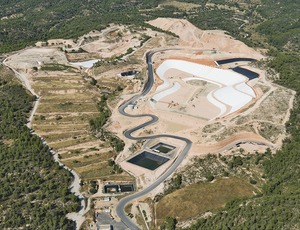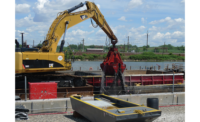
A nasty mix of pollutants—organochlorides, heavy metals and radionuclides—is making remediation of Spain's tainted River Ebro unusually complicated, say engineers managing the $212-million cleanup project.
Decades of pollution had gone officially unobserved until fish started dying near the small town of Flix (pronounced "fleesh"), 80 kilometers west of Tarragona on the Mediterranean Sea. Polluted discharges began flowing when a chemical plant there, now owned by Barcelona-based Ercros S.A., started operation in the late 19th century. There were no regulatory controls until 1985, says José Manuel Plaza, site manager for a joint venture, which that includes Madrid-based firms Getinsa Engineering SL and Eptisa S.A., that provides project support to Acuamed, the government-owned company responsible for regional water resources.
Until a small hydroelectric dam was built in the late 1940s just downstream of the chemical plant, the pollution was diluted in the river's 400-cu-meter-per-second annual average flow that provides water supply for approximately one million area residents.
But with the dam impounding the discharges, pollution began settling in sediment along a more than 1-km stretch of riverfront up to 150 m from the bank. The toxins emerged from a "huge campaign of boreholes" after the dead fish began to appear in 2004, says Plaza.
The Spanish government is funding 30% of the cleanup, with the remainder paid by the European Union through its Cohesion Fund, which supports projects in its 28 member countries that have per-capita gross national incomes under 90% of the EU average. Ercros is providing space for treatment equipment and may make a small cash contribution, depending on the outcome of pending legal action, according to Plaza.
One of the remediation contractor's first tasks when it started work in May 2010 was to enclose the polluted area within a 1.3-km-long, twin-wall sheet-piled cofferdam. The joint venture of FCC Construcción, Madrid, and its affiliate FCC Ámbito sealed more than 1 km of river next to the plant with a wall of 1,600 concrete secant piles, says Maria Sarrado, an FCC site manager.
The contractor also erected four buildings on land within the plant complex to house the multi-stage treatment process that it began using in March. FCC is using a suction dredger on the river to pump sediment to the plant without exposing pollutants to the atmosphere. In an eight-hour shift, the dredger produces enough soil to keep the treatment plant occupied for 24 hours, says Sarrado. FCC tests 500-tonne batches for pollutants, sending them to a landfill if they are not hazardous. In the roughly 20% of potentially hazardous soil, any mercury that may be present is stabilized with the addition of cement.
Volatile organochlorides are oxidized with hydrogen peroxide. Semi-volatile chlorides are treated in a desorption plant in which soil is briefly heated to 320° C. "The problem with desorption is that we can send mercury into the atmosphere," says Plaza. By ensuring the treatment temperature is kept below the 350° C necessary to gasify mercury, FCC avoids air pollution. But any gaseous mercury would be filtered during the gas emissions treatment, and sensors in the plant flue would warn of potential emissions, adds Plaza.
Because the dredging and pumping process requires the soil to flow, some 70% of the volume of material being treated is water, which is treated conventionally by adding phenolic resin to remove radionuclides, says Plaza. Non-hazardous and treated soil is sent to a large, nearby excavated pit, where it is layered with clean earth, says David José Blanco, a senior FCC site engineer. Landfill water runoff is captured in large holding basins and piped for treatment at FCC's plant, he adds. FCC aims to complete remediation in late August 2014, while Ercros recently announced that it is curtailing plant production for unrelated financial reasons.


Post a comment to this article
Report Abusive Comment